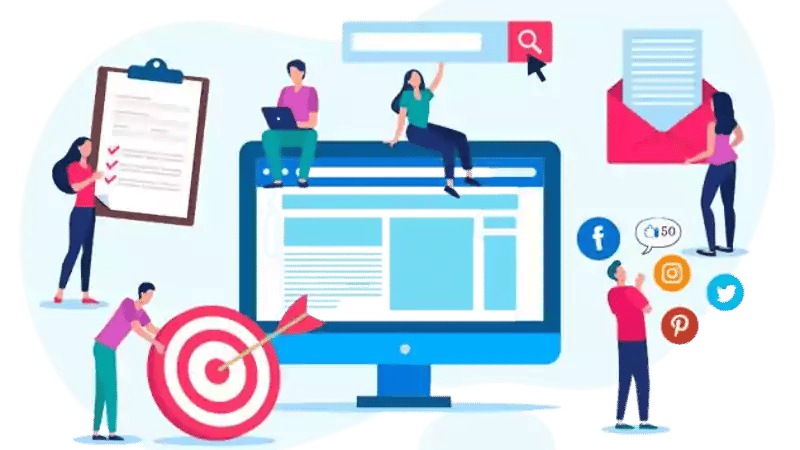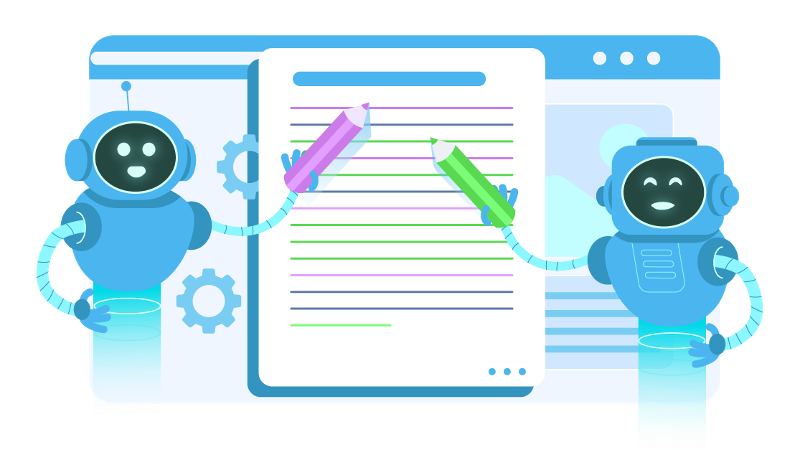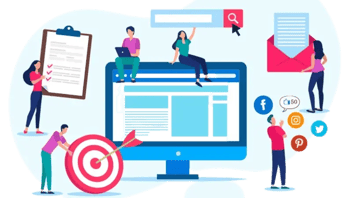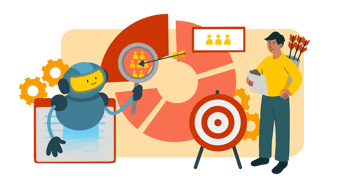Elevate i vostri contenuti con HubSpot Marketing Hub per il content marketing. Scoprite come le nostre strategie e HubSpot portano al successo.
Viaggio dell'acquirente: I migliori contenuti per la fase di awareness
La comprensione del percorso dell'acquirente è fondamentale per il successo nella creazione di contenuti di marketing. Dopo tutto, se date a un visitatore che si avvicina per la prima volta un contenuto pensato per una persona pronta all'acquisto, potreste perdere un cliente prima ancora che mostri interesse. Ecco perché è così importante creare contenuti mirati per ogni fase, a partire dalla consapevolezza.
Comprendere il viaggio dell'acquirente: Fase di consapevolezza
Per avere successo nel content marketing, è essenziale una comprensione fondamentale delle fasi del buyer's journey. Il buyer's journey è un processo ciclico attraverso il quale le persone prendono una decisione d'acquisto. Si compone di tre fasi fondamentali: Consapevolezza, Considerazione e Decisione. Il viaggio inizia con la fase di consapevolezza, in cui i potenziali clienti si rendono conto di un problema o di un bisogno. Questa fase è caratterizzata dalla curiosità e dall'esplorazione, in quanto i consumatori vengono introdotti alle possibili soluzioni.
La fase di consapevolezza è caratterizzata dalla realizzazione da parte del cliente di una sfida o di un desiderio. Che si tratti di riconoscere la necessità di una nuova soluzione, la passione per il miglioramento o semplicemente di scoprire un prodotto o un servizio per la prima volta, questa fase pone le basi per l'intero processo di acquisto. È il momento dell'inizio, in cui un potenziale acquirente passa da uno stato di inconsapevolezza al riconoscimento dell'esistenza di una soluzione - il primo passo cruciale nel percorso di conversione.
L'importanza della fase di consapevolezza risiede nel suo potere di plasmare le percezioni e stabilire la presenza di un marchio nella mente dei potenziali clienti. È il momento perfetto per le aziende per creare un'impressione positiva e duratura, assicurandosi di essere in cima alla memoria quando il potenziale cliente è pronto a muoversi lungo l'imbuto.
Capire la mentalità dei consumatori durante la fase di consapevolezza è essenziale per creare contenuti efficaci. In questa fase iniziale, i potenziali clienti sono curiosi e aperti all'esplorazione. Potrebbero non essere attivamente alla ricerca di un prodotto o servizio specifico, ma sono ricettivi alle informazioni che rispondono alle loro esigenze latenti. La curiosità e il senso di scoperta caratterizzano la loro mentalità, rendendo virale per i brand fornire contenuti di valore, informativi e coinvolgenti che risuonino con i loro interessi in crescita.
Il ruolo dei contenuti
I contenuti eccezionali creano un ponte tra i marchi e il loro pubblico, offrendo preziose intuizioni, soluzioni o intrattenimento in linea con la nuova consapevolezza dei clienti. Che si tratti di blog post avvincenti su , di contenuti per i social media che attirano l'attenzione o di infografiche visivamente accattivanti, i marchi possono tessere narrazioni che educano e stimolano la curiosità del pubblico.
In questa fase, i contenuti devono mostrare in modo sottile l'esperienza del marchio, coltivare la fiducia e fornire informazioni che guidino i consumatori nella comprensione delle loro sfide. In questo modo, i marchi si posizionano come utili alleati, gettando le basi per una relazione più profonda man mano che l'acquirente avanza nelle fasi successive del percorso.
I migliori contenuti per la fase di consapevolezza
La fase di consapevolezza rappresenta l'incontro iniziale tra i marchi e i potenziali clienti, per cui i contenuti devono essere assolutamente informativi e coinvolgenti. Approfondiamo le caratteristiche principali che rendono i contenuti per la fase di awareness efficaci e capaci di catturare l'attenzione di un pubblico eterogeneo e dinamico.
1. Blog approfonditi che affrontano i punti dolenti
I post sui blog sono una pietra miliare dei contenuti digitali, soprattutto nella fase di sensibilizzazione. I contenuti dei blog efficaci devono andare oltre le informazioni superficiali e affrontare i punti dolenti e le sfide che risuonano con il pubblico di riferimento. Potete posizionare il vostro marchio come fornitore di soluzioni comprendendo e immedesimandovi nei problemi del vostro pubblico. Attraverso post di blog approfonditi e ben studiati, i marchi possono stabilire credibilità, costruire fiducia e gettare le basi per una relazione duratura con il pubblico.
L'80% dei responsabili delle decisioni aziendali preferisce ottenere informazioni sull'azienda attraverso una serie di articoli piuttosto che da una pubblicità.
Titoli coinvolgenti e accattivanti nella fase di sensibilizzazione
-
Approccio problema-soluzione: Coinvolgete i lettori presentando un problema che li accomuna, seguito dalla promessa di una soluzione all'interno del contenuto.
-
Ad esempio, "Svelare il mistero della produttività: Una guida completa per aumentare l'efficienza".
-
-
Guide su come fare: Fornite informazioni preziose e attuabili offrendo guide passo-passo. I lettori sono spesso attratti da contenuti che promettono soluzioni alle loro sfide.
-
Un titolo come "Come padroneggiare la gestione del tempo e potenziare la giornata" promette benefici tangibili.
-
-
Domande stimolanti: Stimolate la curiosità con domande che invitano alla riflessione.
-
Per esempio, "State commettendo questi errori comuni nella vostra strategia di marketing?" crea interesse, incoraggiando i lettori a esplorare il contenuto in cerca di risposte.
-
Domande a cui rispondere nella fase di sensibilizzazione
- Qual è il problema del vostro pubblico?
- Perché dovrebbe interessarsi al vostro argomento?
- Quali informazioni possono essere utili?
- Come potete catturare il loro interesse?
- Quali sono i passi successivi per un'ulteriore esplorazione?
- State creando fiducia e credibilità?
- I lettori possono relazionarsi con il vostro contenuto?
Strutturare i contenuti per facilitarne il consumo
-
Paragrafi brevi ed elenchi puntati: Suddividete i contenuti in parti facilmente digeribili. Paragrafi brevi ed elenchi puntati migliorano la leggibilità, consentendo ai lettori di assorbire rapidamente le informazioni. Questo formato si adatta alle abitudini di lettura online del pubblico moderno.
-
Immagini e grafica visivamente accattivanti: Incorporare immagini che completino il testo. Le immagini e la grafica spezzano la monotonia del testo e aiutano a trasmettere le informazioni in modo più efficace. Le immagini pertinenti catturano l'attenzione e migliorano l'estetica generale del blog.
-
Link interni: Guidate i lettori attraverso un viaggio senza soluzione di continuità all'interno dei vostri contenuti incorporando collegamenti interni. Il collegamento di argomenti correlati all'interno del blog incoraggia un'ulteriore esplorazione, mantiene il pubblico impegnato e aumenta la probabilità di interazioni prolungate con il vostro sito web.
Potrebbe piacerti anche...
2. Campagne accattivanti sui social media
Le piattaforme dei social media sono strumenti potenti per raggiungere e coinvolgere un vasto pubblico. Per realizzare campagne accattivanti sui social media è necessario comprendere le dinamiche uniche di ciascuna piattaforma e adattare i contenuti in modo che risuonino con il pubblico di riferimento. L'appeal visivo è fondamentale: grafici, immagini e video che catturano l'attenzione giocano un ruolo cruciale. I contenuti devono essere condivisibili e incoraggiare l'interazione con il pubblico, promuovendo un senso di comunità intorno al marchio. Il ricorso allo storytelling e all'incorporazione di contenuti generati dagli utenti può aumentare l'impatto delle campagne sui social media, creando un'associazione memorabile e positiva con il marchio.
Il 64% dei consumatori afferma che i post condivisi sui social media influenzano le loro decisioni di acquisto.
Scegliere le piattaforme giuste
-
Allineate la scelta della piattaforma di social media con i dati demografici e le preferenze del pubblico (in questo caso sono utili le buyer personas).
-
Considerate il fascino visivo di Instagram, la natura conversazionale di X (Twitter) o il panorama professionale di LinkedIn.
Creare contenuti condivisibili
-
Create contenuti che risuonino emotivamente, intrattengano, istruiscano o forniscano valore.
-
Progettate i contenuti in modo che siano condivisibili, consentendo al vostro pubblico di espandere la portata del vostro marchio in modo organico.
Sfruttare le collaborazioni con gli influencer
-
Identificate gli influencer i cui follower corrispondono al vostro target demografico.
-
Sfruttate gli influencer per ottenere endorsement autentici, portando fiducia e credibilità al messaggio del vostro marchio.
Usare gli hashtag in modo strategico
-
Incorporate hashtag pertinenti per aumentare la scopribilità dei contenuti.
-
Conducete ricerche sugli hashtag specifici per il vostro settore e il vostro pubblico per allinearvi con gli argomenti di tendenza.
3. Infografiche informative
Nell'era del sovraccarico di informazioni, i contenuti visivi sono una componente vitale di una comunicazione efficace. Le infografiche, in particolare, forniscono un formato visivamente accattivante e facilmente digeribile per trasmettere informazioni complesse. La creazione di infografiche informative che semplifichino i concetti chiave e le statistiche relative ai punti dolenti del pubblico può cambiare le carte in tavola nella fase di sensibilizzazione. I contenuti visivi, tra cui immagini, grafiche personalizzate e video, aggiungono una dimensione dinamica al messaggio del marchio, rendendolo più memorabile e condivisibile su varie piattaforme.
Il 41% dei consumatori preferisce conoscere nuovi prodotti attraverso infografiche.
Creare infografiche che semplificano
-
Utilizzate le infografiche per convertire concetti complessi in formati visivamente accattivanti e facilmente digeribili.
-
Combinate testi concisi con grafici accattivanti per migliorare la comprensione e la fidelizzazione.
-
Sfruttate la natura condivisibile delle infografiche per amplificare il vostro messaggio sulle piattaforme digitali.
Immagini e grafica di alta qualità
-
Elevate il fascino visivo con immagini di alta qualità che risuonino con l'identità del vostro marchio.
-
Utilizzate una grafica personalizzata per stabilire una presenza online distintiva e favorire il riconoscimento del marchio.
-
Assicuratevi che le immagini siano in linea con l'estetica e la messaggistica del marchio per un'identità digitale coesa.
Incorporate i video
-
Create connessioni dinamiche e personali con il vostro pubblico attraverso i video.
-
Utilizzate i video per le dimostrazioni dei prodotti, i contenuti dietro le quinte e lo storytelling.
-
Utilizzate piattaforme come YouTube, Instagram e TikTok per condividere contenuti video diversi e coinvolgere in modo autentico il vostro pubblico.
4. Podcast e webinar
La popolarità dei contenuti audio è aumentata negli ultimi anni, con podcast e webinar che si sono affermati come centri di formazione. I podcast, in particolare, offrono al pubblico un modo comodo e accessibile per consumare informazioni mentre è impegnato nel multitasking. I marchi possono utilizzare i podcast per condividere approfondimenti sul settore, discutere di argomenti rilevanti e posizionarsi come leader di pensiero.
Il 51% degli acquirenti B2B ascolta podcast nella fase di consapevolezza.
Podcast educativi per affermare la leadership di pensiero
-
I podcast rappresentano una piattaforma unica per i marchi per stabilire una leadership di pensiero.
-
I podcast educativi offrono preziose intuizioni, analisi e prospettive di esperti.
-
Il posizionamento del marchio come voce autorevole aumenta la credibilità e rafforza le connessioni con il pubblico.
I webinar, invece, forniscono una piattaforma più interattiva per educare il pubblico. Consentono il coinvolgimento in tempo reale, le sessioni di domande e risposte e l'approfondimento degli argomenti, favorendo un senso di connessione e fiducia tra il marchio e il suo pubblico.
Webinar interattivi per un coinvolgimento diretto del pubblico
-
I webinar offrono un'esperienza interattiva e dal vivo per un coinvolgimento diretto.
-
Caratteristiche come sessioni di domande e risposte, sondaggi e discussioni in tempo reale favoriscono un senso di comunità.
-
I webinar vanno oltre la fornitura di informazioni; consentono ai marchi di costruire relazioni attraverso un dialogo bidirezionale.
I contenuti efficaci per la fase di consapevolezza richiedono una miscela di creatività, empatia e comunicazione strategica. I post di approfondimento sui blog affrontano i punti dolenti, le campagne accattivanti sui social media creano una comunità, le immagini informative semplificano idee complesse e i podcast/webinar offrono esperienze educative coinvolgenti. Incorporando queste caratteristiche chiave nella loro strategia di contenuti, i brand possono catturare l'attenzione durante l'awareness e creare connessioni significative e durature durante il buyer's journey.
Suggerimenti per l'ottimizzazione SEO
La creazione di contenuti è uno sforzo inutile se non si riesce a raggiungere il pubblico. È qui che entra in gioco l'ottimizzazione per i motori di ricerca (SEO).
Posizionamento strategico delle parole chiave
Le parole chiave sono gli elementi costitutivi della SEO e il loro posizionamento strategico è fondamentale. Identificate parole chiave pertinenti e in linea con i vostri contenuti e il vostro pubblico di riferimento. Integrate queste parole chiave in modo naturale nei titoli, nelle intestazioni e in tutto il contenuto. Scrivete meta-descrizioni convincenti con parole chiave per informare i motori di ricerca sui vostri contenuti e invogliare gli utenti a cliccare. Il giusto equilibrio garantisce che il contenuto sia adatto ai motori di ricerca e agli utenti, per soddisfare gli algoritmi e i lettori umani.
Backlink di qualità per l'autorevolezza
I backlink segnalano autorità e credibilità ai motori di ricerca. Concentratevi sull'acquisizione di backlink pertinenti e di alta qualità provenienti da fonti affidabili del vostro settore. I backlink naturali e organici provenienti da siti web autorevoli aumentano la credibilità del sito e influiscono positivamente sul posizionamento nei motori di ricerca. Per attirare backlink di qualità, è necessario stringere relazioni all'interno del proprio settore, partecipare al guest posting e creare contenuti condivisibili e degni di link. Una strategia di backlink accurata testimonia l'autorità del vostro sito nel mondo digitale.
Ottimizzare immagini e multimedia
I contenuti visivi sono fondamentali per il coinvolgimento degli utenti e l'ottimizzazione delle immagini e degli elementi multimediali contribuisce al successo SEO complessivo. Comprimete le immagini senza compromettere la qualità per migliorare i tempi di caricamento delle pagine, un fattore cruciale per il posizionamento sui motori di ricerca. Utilizzate nomi di file e testi alt descrittivi che includano parole chiave pertinenti, fornendo ai motori di ricerca un contesto sul contenuto. L'implementazione di un design reattivo garantisce che gli elementi multimediali migliorino l'esperienza dell'utente su vari dispositivi, contribuendo a migliorare il posizionamento sui motori di ricerca.
Potrebbe piacerti anche:
Come utilizziamo HubSpot Content Hub per la SEO
Scoprite come utilizziamo HubSpot Content Hub per la SEO, aumentare il traffico organico e ottimizzare i nostri contenuti per il successo.
Guida passo per passo alla creazione di contenuti per la fase di sensibilizzazione
Supponiamo di essere un content marketer a cui è stato assegnato il compito: "Scrivi di questo argomento per la fase di sensibilizzazione". Ecco le istruzioni passo per passo su cosa fare per superare questa fase del percorso dell'acquirente.
-
Definite il pubblico di riferimento. Identificate il pubblico specifico che volete raggiungere nella fase di consapevolezza. Comprendete i loro dati demografici, gli interessi e i punti dolenti per adattare i vostri contenuti in modo efficace.
-
Selezionare un argomento rilevante. Scegliete un argomento che sia in linea con le esigenze e gli interessi del vostro pubblico target. Considerate le sfide comuni che potrebbero affrontare e scegliete un argomento che offra soluzioni o intuizioni preziose.
-
Creare un titolo accattivante. Create un titolo che catturi l'attenzione e susciti curiosità. Utilizzate l'approccio problema-soluzione, le guide su come fare o le domande che stimolano la riflessione per attirare i lettori e incoraggiarli ad approfondire.
-
Affrontare i punti dolenti. Identificate e affrontate i punti dolenti o le sfide che il vostro pubblico target potrebbe vivere. Il contenuto deve immedesimarsi nella loro situazione e offrire uno sguardo alle potenziali soluzioni.
-
Evidenziare la rilevanza e l'importanza. Comunicate perché l'argomento scelto è rilevante e importante per il pubblico. Illustrate in che modo il coinvolgimento con il contenuto sarà vantaggioso per loro e contribuirà alla loro comprensione o al loro miglioramento in un'area specifica.
-
Fornire valore e informazioni. Offrite informazioni preziose che istruiscano e informino. Considerate il tipo di contenuto che dà potere al pubblico, aumenta la sua consapevolezza e contribuisce positivamente al suo percorso.
-
Catturare l'interesse attraverso il coinvolgimento. Create il contenuto per catturare e mantenere l'interesse dei lettori. Utilizzate una narrazione coinvolgente, statistiche o esempi che risuonino con il pubblico e lo coinvolgano nel messaggio.
-
Guida all'approfondimento. Includete CTA chiare che guidino i lettori nel loro viaggio di esplorazione. Incoraggiateli a esplorare i contenuti correlati, a iscriversi agli aggiornamenti o a impegnarsi con il vostro marchio sui social media.
-
Creare fiducia e credibilità. Instaurate un rapporto di fiducia condividendo credenziali, casi di studio o testimonianze che dimostrino la vostra competenza. La costruzione della credibilità nella fase di consapevolezza getta le basi per un rapporto di maggiore fiducia man mano che il pubblico progredisce.
-
Infondere relatività. Utilizzate un linguaggio e degli esempi che rendano il contenuto relazionabile al vostro pubblico di riferimento. Fate in modo che si sentano compresi e connessi, aumentando la risonanza complessiva del messaggio.
-
Mantenere un tono amichevole e accessibile. Mantenete un tono amichevole e accessibile in tutto il contenuto. Evitate il gergo che potrebbe allontanare i lettori e puntate su uno stile colloquiale che favorisca un senso di connessione.
-
Garantire una prima impressione memorabile. La fase di sensibilizzazione consiste nel fare una prima impressione memorabile. Realizzate il contenuto in modo da lasciare un'impronta positiva nella mente del pubblico, rendendolo più propenso a impegnarsi ulteriormente nel percorso dell'acquirente.
Seguendo queste istruzioni passo dopo passo, è possibile creare contenuti su misura per la fase di sensibilizzazione, assicurandosi che risuonino con il pubblico, catturino l'attenzione e pongano le basi per una relazione significativa e duratura.
Deliziare ed educare i clienti nella fase di sensibilizzazione
Sebbene la consapevolezza sia solo la prima fase del percorso dell'acquirente, è probabilmente la più importante. Questa fase attira i potenziali clienti, li fa entrare nel percorso dell'acquirente e, in ultima analisi, porta a opportunità di conversione. La creazione di contenuti è alla base della fase di consapevolezza, ma è importante essere strategici nel determinare quali tipi di contenuti utilizzare.
Contenuti semplici ed educativi come blog, post sui social media e infografiche sono ottimi modi per informare i potenziali clienti sulle soluzioni ai loro problemi. Non state vendendo il vostro prodotto e imponendo loro contenuti di vendita, ma dimostrando in modo sottile il vostro valore e la vostra competenza. Integrando perfettamente questi contenuti nella vostra strategia di marketing, la vostra azienda può affascinare il pubblico e creare legami duraturi.
Una volta superata la fase della consapevolezza, è il momento di guidare i potenziali clienti verso la fase della considerazione.
Questo contenuto è disponibile in:
- Tedesco: Die Buyer's Journey: Inhalte für die Awareness-Phase
- Inglese: The Buyer's Journey: Best Content for the Awareness Stage
- Spagnolo: El buyer journey: El mejor contenido para la fase de concienciación
- Francese: Le parcours de l'acheteur : Contenu pour l'étape de sensibilisation
- Rumeno: Călătoria cumpărătorului: Cel mai bun conținut pentru faza Awareness
- Cinese: 买家之旅:认知阶段的最佳内容












Facci sapere cosa ne pensi.